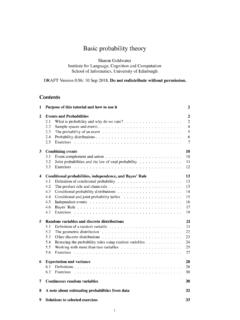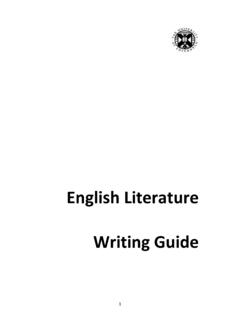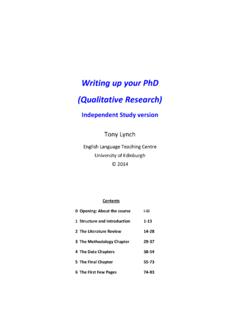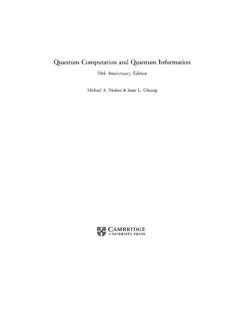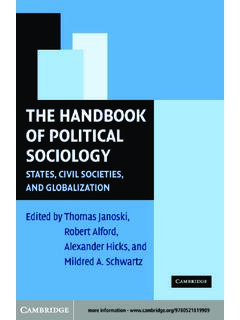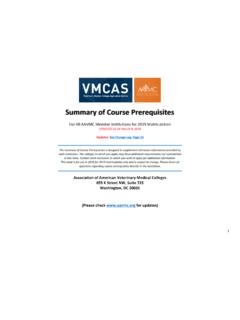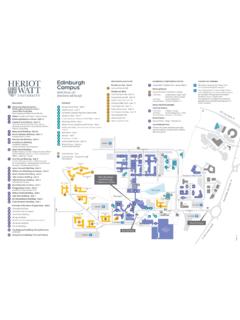Transcription of Texture Analysis - Purdue University
1 Michael A. Wirth, of GuelphComputing and Information ScienceImage Processing Group 2004 Texture Analysis2 What is Texture ? Texture is a feature used to partition images into regions of interest and to classify those regions. Texture provides information in the spatial arrangement of colours or intensities in an image. Texture is characterized by the spatial distribution of intensity levels in a is Texture ? Texture is a repeating pattern of local variations in image intensity: Texture cannot be defined for a is Texture ? For example, an image has a 50% black and 50% white distribution of pixels. Three different images with the same intensity distribution, but with different Texture consists of Texture primitivesor Texture elements, sometimes called texels. Texture can be described as fine, coarse, grained, smooth, etc. Such features are found in the toneand structureof a Texture . Tone is based on pixel intensity properties in the texel, whilst structure represents the spatial relationship between If texels are small and tonal differences between texels are large a finetexture results.
2 If texels are large and consist of several pixels, a coarsetexture Analysis There are two primary issues in Texture Analysis :ntexture classificationotexture segmentation Texture segmentationis concerned with automatically determining the boundaries between various Texture regions in an image. Reed, and Dubuf, CVGIP: Image Understanding, 57: pp. 359-372. Classification Texture classificationis concerned with identifying a given textured region from a given set of Texture classes. Each of these regions has unique Texture characteristics. Statistical methods are extensively GLCM, contrast, entropy, homogeneity9 Defining Texture There are three approaches to defining exactly what Texture is:cStructural: Texture is a set of primitive texels in some regular or repeated : Texture is a quantitative measure of the arrangement of intensities in a region. This set of measurements is called a feature : Texture modelling techniques involve constructing models to specify Texture Statistical methods are particularly useful when the Texture primitives are small, resulting in microtextures.
3 When the size of the Texture primitive is large, first determine the shape and properties of the basic primitive and the rules which govern the placement of these primitives, forming Analysis of Texture12 Range One of the simplest of the Texture operators is the rangeor difference between maximum and minimum intensity values in a neighborhood. The range operator converts the original image to one in which brightness represents Another estimator of Texture is the variancein neighborhood regions. This is the sum of the squares of the differences between the intensity of the central pixel and its Texture Measures Numeric quantities or statistics that describe a Texture can be calculated from the intensities (or colours) themselves15 Grey Level Co-occurrence The statistical measures described so far are easy to calculate, but do not provide any information about the repeating nature of Texture . A gray level co-occurrence matrix(GLCM) contains information about the positions of pixels having similar gray level A co-occurrence matrixis a two-dimensional array, P, in which both the rows and the columns represent a set of possible image values.
4 A GLCM Pd[i,j] is defined by first specifying a displacement vector d=(dx,dy) and counting all pairs of pixels separated by dhaving gray levels i and j. The GLCM is defined by:[, ]dijPij n=17 GLCM where nijis the number of occurrences of the pixel values (i,j) lying at distance din the image. The co-occurrence matrix Pdhas dimension n n, where nis the number of gray levels in the For example, if d=(1,1)there are 16 pairs of pixels in the image which satisfy this spatial separation. Since there are only three gray levels, P[i,j] is a 3 3 : Count all pairs of pixels in which the first pixel has a value i,and its matching pair displaced from the first pixel by dhas a value of j. This count is entered in the ithrow and jthcolumn of the matrix Pd[i,j] Note that Pd[i,j] is not symmetric, since the number of pairs of pixels having gray levels [i,j] does not necessarily equal the number of pixel pairs having gray levels [j,i].20 Normalised GLCM The elements of Pd[i,j] can be normalised by dividing each entry by the total number of pixel GLCM; N[i,j], defined by: which normalises the co-occurrence values to lie between 0 and 1, and allows them to be thought of as probabilities.
5 [, ][, ][, ]ijPi jNi jPi j= 21 Numeric Features of GLCM Gray level co-occurrence matrices capture properties of a Texture but they are not directly useful for further Analysis , such as the comparison of two textures. Numeric featuresare computed from the co-occurrence matrix that can be used to represent the Texture more Probability This is simply the largest entry in the matrix, and corresponds to the strongest response. This could be the maximum in any of the matrices or the maximum overall.,max[ , ]mdijCPij=23 Maximum Probability Maximum probability with w=21, and d=(2,2)24 Moments The order kelement difference moment can be defined as: This descriptor has small values in cases where the largest elements in Pare along the principal diagonal. The opposite effect can be achieved using the inverse moment.()[,]kkdijMomij P i j= [, ],()dkkijPijMomijij= 25 Moments Moments with w=21, and d=(2,2)26 Contrast Contrast is a measure of the local variations present in an image.
6 If there is a large amount of variation in an image the P[i,j] s will be concentrated away from the main diagonal and contrast will be high. (typically k=2, n=1)(, )() [,]nkdijCkni j P i j= 27 Contrast Contrast with w=21, and d=(2,2)28 Homogeneity A homogeneous image will result in a co-occurrence matrix with a combination of high and low P[i,j] s. Where the range of graylevels is small the P[i,j] will tend to be clustered around the main diagonal. A heterogeneous image will result in an even spread of P[i,j] s.[, ]1dhijPijCij=+ 29 Homogeneity Homogeneity with w=21, and d=(2,2)30 Entropy Entropy is a measure of information content. It measures the randomness of intensity distribution. Such a matrix corresponds to an image in which there are no preferred graylevel pairs for the distance vector d. Entropy is highest when all entries in P[i,j] are of similar magnitude, and small when the entries in P[i,j] are unequal.[, ]ln [, ]eddijCPijPij= 31 Entropy Entropy with w=21, and d=(2,2)32 Correlation Correlation is a measure of image linearity Correlation will be high if an image contains a considerable amount of linear structure.
7 [][, ]dijijcijijP i jC = 222[, ],[, ]id id iiP ijiP ij == 33 GLCM - References Carlson, and Ebel. "Co-occurrence matrix modification for small region Texture measurement and comparison". in IGARSS'88-Remote Sensing: Moving Towards the 21st Century, , IEEE, edinburgh , Scotland. 1988. Argenti, F., L. Alparone, and G. Benelli, "Fast algorithms for Texture Analysis using co-occurrence matrices". IEE Proceedings, Part F: Radar and SIgnal Processing, 137(6): pp. 443-448. 1990. Gotlieb, and Kreyszig, "textur descriptors based on co-occurrence matrices". Computer Vision, Graphics and Image Processing, 51(1): pp. 70-86. with GLCM One problem with deriving Texture measures from co-occurrence matrices is how to choose the displacement vector d. The choice of the displacement vector is an important parameter in the definition of the GLCM. Occasionally the GLCM is computed from several values of dand the one which maximises a statistical measure computed from P[i,j] is used.
8 Zucker and Terzopoulos used a 2measure to select the values of dthat have the most structure; to maximise the value:22[, ]()1[] [ ]dijddPijdPiP j = 35 Windowing Algorithms for Texture Analysis are applied to an image in a series of windows of size w, each centered on a pixel (i,j). The value of the resulting statistical measure are assigned to the position (i,j) in the new Texture Operator Haralick et al. suggested a set of 14 textural features which can be extracted from the co-occurrence matrix, and which contain information about image textural characteristics such as homogeneity, linearity, and contrast. Haralick, , K. Shanmugam, and I. Dinstein, "Textural features for image classification". IEEE Transactions on Systems, Man and Cybernetics: pp. 610-621. Difference Statistics Grey-level differencesare based on absoute differences between pairs of grey-levels. The grey-level differences are contained in a 256-element vector, and are computed by taking the absolute differences of all possible pairs of grey levels distance dapart at angle , and counting the number of times the difference is 0,1.
9 ,25538 Graylevel Difference Statistics Let d=(dx,dy) be the displacement vector between two image pixels, and g(d) the gray-level difference at distance d. pg(g,d) is the histogram of the gray-level differences at the specific distance, d. One distinct histogram exists for each distance d.() (,) (,)gdf i j f i dx j dy= ++39 Graylevel Difference Statistics The difference statistics are then normalized by dividing each element of the vector by the number of possible pixel pairs. Several Texture measures can be extracted from the histogram of graylevel differences:40 Graylevel Difference Statistics Mean: Small mean values dindicate coarse Texture having a grain size equal to or larger than the magnitude of the displacement vector. Entropy: This is a measure of the homogeneity of the histogram. It is maximised for uniform (,)Ndkgkkgp g d == 1(,)ln (,)NdgkgkkHpgdpgd== 41 Graylevel Difference Statistics Variance: The variance is a measure of the dispersion of the gray-level differences at a certain distance, d.
10 Contrast:221()(,)Ndkdgkkgpgd == 21(,)NdkgkkCgpgd== 42 Graylevel Difference StatisticsMeanStandard Deviation EntropyContrast43 Runlength Statistics The lengths of Texture primitives in different directions can serve as a Texture description. A run lengthis a set of constant intensity pixels located in a line. Runlength statisticsare calculated by counting the number of runs of a given length (from 1 to n) for each grey level. Galloway, , " Texture classification using gray level run lengths".Computer Graphics and Image Processing, 4(2): pp. 172-179. Statistics In a course Texture it is expected that long runs will occur relatively often, whereas a fine Texture will contain a higher proportion of short runs. Statistical measures: Let B(a,r) be the number of primitives of all directions having length r, and grey-level a, m and nthe image dimensions, and Lthe number of intensity values. Let Kbe the number of runs:11(,)LNrarKBar=== 45 Runlength StatisticscLong-run emphasis: This is a measure that emphasizes the long-runs of a gray-level image.


